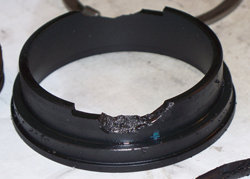Indisputably, mechanical seal failure is the most common cause of pump downtime. Operators and engineers in plants of all sizes and industries will vouch for it. In this blog, we will talk about most common causes of seal failure and how to prevent such frequent failures
Worn Out or Failed?
A mechanical seal can either wear out or fail. Look at the wearable face of the seal (typically carbon/ graphite). If this seal face is little remaining carbon nose, the seal is worn out. If the carbon face is substantial, seal has failed.

Seal failure rates are generally in excess of 85%. Good news is, for most part, such seal failures are correctible.
Dry Running/ Lack of Lubrication
Mechanical seal faces must stay together. The seal faces require lubrication to absorb the heat. Consider following instances where lack of lubrication will result in heat generation and subsequent seal failure:
- If pump is running dry, there is no liquid inside the pump; and hence, no liquid to lubricate seal faces
- At high temperature or liquid pumped at close to their vapor pressure, the liquid is hardly lubricating
- Double seal pump running without any buffer liquid/ seal plan
With proper mechanical seal flush plans, all such failures can be avoided. One need to ensure that flush media is compatible with the liquid pumped.
Improper Seal Selection
Improper seal selection will lead to seal failure:
- Chemical compatibility: All seal components, be it seal faces or o-rings, must be compatible with not only process fluid being pumping but also non-process fluids (cleaning media, steam, acid, and caustic flushes etc).
- Physical degradation: Using soft faces on abrasive liquid will not last. Shear sensitive liquids, such as Chocolate, can disintegrate leaving solids (cocoa powder) and squeezing out liquids (oil).
- Sedimentation Certain process requires larges fluctuation in temperature, viscosity, pressure, speed etc. These constantly changing conditions increase the risk of sedimentation in or near the sealing gaps between seal faces. Also think about liquids that tends to solidify (crystallize) quickly and scale on seal faces. As the deposits accumulate on the seal faces, the sealing gap opens further. The leakage can start slowly but will increase over time. Abrasive particles can also lead to seal face damage.
- Temperature: Elastomers can swell. Lapped hard faces are especially sensitive to changes in temperature.
- Viscosity: Viscous products may restrict the free movement of the seal. Remember some liquids become more viscous with agitation (such as cream turns into butter)
Operator Error

- Skipping initial start-up procedures and installation errors are commonplace.
- Hammering couplings onto the shaft will most likely damage seal faces
- Remember last time you open the pump and seal was damaged during seal removal or cleaning. Carbon, Silicon Carbide- common seal face material, is very brittle and mishandling can easily chip seal faces, resulting in seal failures. Moreover, seal faces are lapped to better than 3 light bulb, so they are very sensitive. Even small amount of dirt or oil, even fingerprints, can cause the faces to not align.
- When a pump is taken off line, if it is not properly cleaned, product can solidify on the seals and essentially “lock” the seal faces together. When the pump is started again, the initial motor torque will damage the stuck seals.
Careful handling of the seal and ensuring no product residue in the pump (by CIP/ COP) will help avoid above issues.
Vibration/ Alignment
Vibration can be attributed to several reasons- pump and drive misalignment, bent or warped shafts, worn or loose bearings, unbalanced rotating components, running pump beyond catalog limits etc. Vibration can cause seal face chipping and seal opening. Seal face opening can result in contaminants to penetrate between the faces causing premature wear.
In conclusion, mechanical seal failure is often a combination of a variety of factors: lack of lubrication at seal faces, improper selection, operator error, vibration. By taking appropriate measures, such failures could be avoided, resulting in more uptime, more production.
